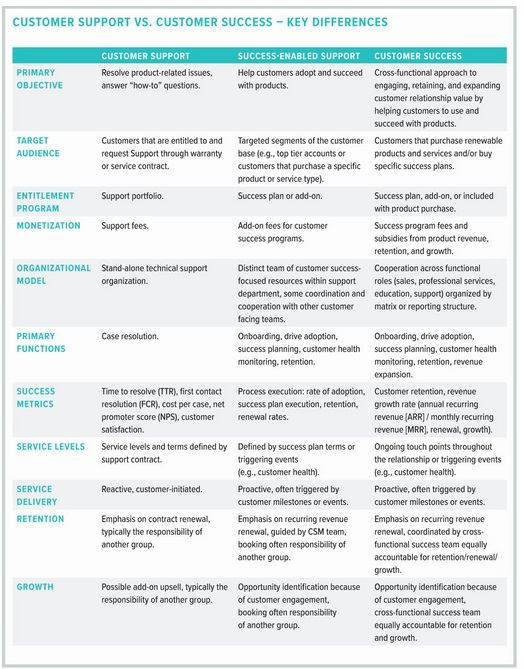Differentiating Customer Support And Customer Success (And Why It Matters For Your Software Company)
By ThomasJ. Sweeny
True customer success stands out from a support operation – it’s a transformation and cooperation across many departments that introduces new ways to define your business.
 The term customer success permeates the software industry today, and the focus and awareness of it is timely and refreshing. I don’t mean to imply that software companies have not been focused on making customers successful in the past, but this emphasis on customer success has created a new level of awareness and commitment to truly impact customers’ ability to derive benefits from software. Customer success has profound implications for the ways software companies engage, serve, and retain customers.
The term customer success permeates the software industry today, and the focus and awareness of it is timely and refreshing. I don’t mean to imply that software companies have not been focused on making customers successful in the past, but this emphasis on customer success has created a new level of awareness and commitment to truly impact customers’ ability to derive benefits from software. Customer success has profound implications for the ways software companies engage, serve, and retain customers.
As we rush to embrace customer success, it is imperative that we have a shared understanding about what it is and is not. All too often customer success initiatives involve little more than changing the name of the support department or adding a few new roles to focus on success-related activities. Don’t get me wrong — every step towards a customer success-oriented approach is positive. But if your software company truly wants to pursue customer success, you need to understand what it is and why it is different from traditional customer support models.
CUSTOMER SUCCESS: FUNCTIONS VS. PHILOSOPHY
It is important to distinguish between customer success- focused activities (functions) and customer success as an operating model (philosophy). Support and many customer-facing departments have been engaged in success-focused practices long before we started labeling them as customer success. Today, perhaps we label too many things as customer success. By instituting customer success functions (onboarding, driving adoption, customer health indexing, success management, etc.) within support, we do not necessarily achieve a customer success-focused way of conducting business. True customer success requires transformation and cooperation across many departments and introduces new ways to define and measure business performance.
THE SUCCESS SPECTRUM
We need to recognize that there are variations of customer success. Customer success has specific functions, roles, and ways of conducting business. If you embrace a few customer-success focused activities or have roles with customer success in the title, it does not mean you have fully embraced customer success. I have defined three distinct stages in the success spectrum:

- CUSTOMER SUPPORT — Traditional technical support functions focused on issue resolution and answering how-to questions, primarily in response to customer questions.
- SUCCESS-ENABLED SUPPORT — Introduction of success-focused roles such as customer success managers and adoption of success practices such as onboarding, health assessments, journey mapping, and success planning. Introduction of proactive customer engagement.
- CUSTOMER SUCCESS — Cross-functional cooperation or organizational alignment primarily focused on customer engagement and proactive service delivery. Primary business objective is to retain and grow relationship value.
CUSTOMER SUPPORT — A CORNERSTONE OF THE CUSTOMER RELATIONSHIP
Customer support is a practice that seems to be as old as the software industry itself. For many companies, the support department is the primary interface with customers after the initial sale. The mission of support is to be there for the customer when it needs help, but not necessarily to engage customers proactively to assure that they can use and apply their applications. Once again, this is not to suggest that companies or support organizations are not committed to helping customers succeed — some of the most committed and customer-centric people in the software industry can be found within support. The fact is that traditional support organizations typically do not have a mandate, nor the resources, to fully drive customer success outcomes.
SUCCESS-ENABLED SUPPORT — A HYBRID APPROACH
Somewhere between a traditional customer support organization and a full-fledged customer success initiative is a hybrid model that introduces success-focused practices and resources into support. “Success-Enabled Support” includes success-focused roles such as customer success managers, onboarding and adoption specialists, and retention, renewal, and upsell experts. Practices include formal onboarding, efforts to drive adoption, and plans to define and drive successful outcomes (success plans and journey maps). These success-focused resources and activities are a quantum leap towards customer success. Yet they are often contained within siloed organizational structures or lack full organizational commitment and governance to truly drive an enterprisewide coordination to maximize retention and relationship growth.
CUSTOMER SUCCESS — A BUSINESS MODEL
Customer success is a strategy to maximize customer retention and create opportunities for revenue expansion within the customer base. It is not simply an organizational structure, function, process, team, or job description — customer success is a customer engagement and retention philosophy. It should be seen as a way of doing business that transcends all aspects of a company, from the way it develops products to the way it sustains and expands customer relationships.
Customer success is predicated on the understanding that a significant portion of revenue and growth comes from existing customer relationships and that for software vendors to grow relationship value their customers must be able to apply and succeed with the products they have purchased. This is a critical methodology for companies that depend on recurring revenues from license, maintenance, and other service subscriptions. Customer success is not, however, just for companies that sell SaaS products. Companies that sell perpetual software licenses or devices can benefit from customer success to drive product adoption and to assure maintenance contract renewals.
THE JOURNEY TO CUSTOMER SUCCESS
The journey to customer success may not require the full transformation to an entirely new way of conducting business, organizing resources, or measuring business performance. Adopting some success-focus activities and creating success roles may be adequate for your business. For companies that depend upon recurring revenues, customer retention and relationship growth are paramount, and a true customer success operating mode is an effective strategy. Be honest about where you are in your journey and what approach to customer success is appropriate to your business. Be careful not to overstate where you are in your journey if you have farther to go.
THOMAS J. SWEENY is the founder and principal of ServiceXRG. He leads research initiatives and publishes extensively about service industry trends and best practices. He helps companies develop and execute service strategies to strengthen customer relationships and optimize financial performance.
